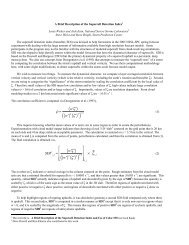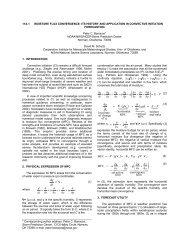Possible Impacts of the Enhanced Fujita Scale on United States ...
Possible Impacts of the Enhanced Fujita Scale on United States ...
Possible Impacts of the Enhanced Fujita Scale on United States ...
You also want an ePaper? Increase the reach of your titles
YUMPU automatically turns print PDFs into web optimized ePapers that Google loves.
Table 1. Absolute numbers <str<strong>on</strong>g>of</str<strong>on</strong>g> tornadoes by time bin (columns) and categories (rows). “Any 3 Avg” c<strong>on</strong>stitutes a sum<br />
<str<strong>on</strong>g>of</str<strong>on</strong>g> <str<strong>on</strong>g>the</str<strong>on</strong>g> entire 15 years divided by 5 to yield an “average 3-year bin.” Red (blue) colored values represent those above<br />
(below) <str<strong>on</strong>g>the</str<strong>on</strong>g> “average 3-year bin” for <str<strong>on</strong>g>the</str<strong>on</strong>g>ir categories. Weak, str<strong>on</strong>g and violent tornado categories represent EF/F0-<br />
1, EF/F2-3, and EF/F4-5 respectively, following comm<strong>on</strong> c<strong>on</strong>venti<strong>on</strong>s in <str<strong>on</strong>g>the</str<strong>on</strong>g> literature dating back to <str<strong>on</strong>g>Fujita</str<strong>on</strong>g> (1976).<br />
Significant tornadoes were rated ≥EF/F2. The EF-<str<strong>on</strong>g>Scale</str<strong>on</strong>g> era is shaded in gray.<br />
COUNTS 2007-2009 2004-2006 2001-2003 1998-2000 1995-1997 Any 3 Avg<br />
EF/F 0 2360 2717 2324 2436 2308 2429<br />
EF/F 1 1145 1106 849 972 878 990<br />
EF/F 2 326 281 256 300 277 288<br />
EF/F 3 96 73 75 106 69 83.8<br />
EF/F 4 15 8 19 21 22 17<br />
EF/F 5 2 0 0 3 2 1.4<br />
Weak 3505 3823 3173 3408 3186 3419<br />
Str<strong>on</strong>g 422 354 331 406 346 372<br />
Violent 17 8 19 24 24 18.4<br />
Significant 439 362 350 430 370 390<br />
EF/F 1 & 2 1471 1387 1105 1272 1155 1278<br />
Total Tors 3944 4185 3523 3838 3556 3809.2<br />
Table 2. As in Table 1, except expressed as percentages <str<strong>on</strong>g>of</str<strong>on</strong>g> <str<strong>on</strong>g>the</str<strong>on</strong>g> total number <str<strong>on</strong>g>of</str<strong>on</strong>g> tornado records in each 3-year bin.<br />
Percentages may not add precisely to 100 due to rounding.<br />
PERCENTS 2007-2009 2004-2006 2001-2003 1998-2000 1995-1997 Any 3 Avg<br />
EF/F 0 59.8 64.9 65.9 63.4 64.9 63.8<br />
EF/F 1 29.0 26.4 24.1 25.3 24.6 26.0<br />
EF/F 2 8.2 6.7 7.2 7.8 7.8 7.6<br />
EF/F 3 2.4 1.7 2.1 2.8 1.9 2.2<br />
EF/F 4 0.4 0.2 0.5 0.5 0.6 0.4<br />
EF/F 5 0.05 0 0 0.08 0.06 0.04<br />
Weak 88.9 91.4 90.0 88.8 89.6 89.8<br />
Str<strong>on</strong>g 10.7 8.5 9.4 10.6 9.7 9.8<br />
Violent .43 .19 .54 .62 .67 .48<br />
Significant 11.1 8.6 9.9 11.2 10.4 10.2<br />
EF/F 1 & 2 37.3 33.1 31.3 33.1 32.4 33.6<br />
Total Tors 100 100 100 100 100 100<br />
comparis<strong>on</strong>s <str<strong>on</strong>g>of</str<strong>on</strong>g> raw trends during this era (e.g.,<br />
without <str<strong>on</strong>g>the</str<strong>on</strong>g> obvious need for detrending), basic<br />
tendencies are examined in <str<strong>on</strong>g>the</str<strong>on</strong>g> nati<strong>on</strong>wide SPC<br />
“ONETOR” data across <str<strong>on</strong>g>the</str<strong>on</strong>g> 1995-2009 time frame,<br />
c<strong>on</strong>taining 19,046 records. The data could be<br />
examined in <str<strong>on</strong>g>the</str<strong>on</strong>g> form <str<strong>on</strong>g>of</str<strong>on</strong>g> five three-year bins, <str<strong>on</strong>g>the</str<strong>on</strong>g> last<br />
covering <str<strong>on</strong>g>the</str<strong>on</strong>g> EF <str<strong>on</strong>g>Scale</str<strong>on</strong>g> era. Because January 2007,<br />
which was <strong>on</strong>e m<strong>on</strong>th prior to <str<strong>on</strong>g>the</str<strong>on</strong>g> implementati<strong>on</strong> <str<strong>on</strong>g>of</str<strong>on</strong>g><br />
<str<strong>on</strong>g>the</str<strong>on</strong>g> EF <str<strong>on</strong>g>Scale</str<strong>on</strong>g>, c<strong>on</strong>tained <strong>on</strong>ly 21 tornado records (out<br />
<str<strong>on</strong>g>of</str<strong>on</strong>g> 1117, or 1.9% <str<strong>on</strong>g>of</str<strong>on</strong>g> <str<strong>on</strong>g>the</str<strong>on</strong>g> yearly total), for temporal<br />
c<strong>on</strong>tinuity <str<strong>on</strong>g>the</str<strong>on</strong>g>y are included with those for <str<strong>on</strong>g>the</str<strong>on</strong>g> rest <str<strong>on</strong>g>of</str<strong>on</strong>g><br />
2007, and for <str<strong>on</strong>g>the</str<strong>on</strong>g> 2007-2009 bin as a whole.<br />
Various absolute tornado totals for <str<strong>on</strong>g>the</str<strong>on</strong>g> entire<br />
period, and for each three-year bin, are shown in<br />
Table 1. Table 2 takes each 3-yearly bin’s c<strong>on</strong>tents<br />
from Table 1 as a percentage <str<strong>on</strong>g>of</str<strong>on</strong>g> total tornadoes in <str<strong>on</strong>g>the</str<strong>on</strong>g><br />
bin, in order to compare relative occurrence <str<strong>on</strong>g>of</str<strong>on</strong>g><br />
different damage classes across bins, and<br />
independently <str<strong>on</strong>g>of</str<strong>on</strong>g> <str<strong>on</strong>g>the</str<strong>on</strong>g> changes in absolute numbers <str<strong>on</strong>g>of</str<strong>on</strong>g><br />
tornadoes from period to period. From <str<strong>on</strong>g>the</str<strong>on</strong>g>se data,<br />
several trends become apparent. The period<br />
c<strong>on</strong>taining <str<strong>on</strong>g>the</str<strong>on</strong>g> most tornadoes, 2004-2006, also<br />
c<strong>on</strong>tained <str<strong>on</strong>g>the</str<strong>on</strong>g> fewest violent tornadoes, nearly an<br />
order <str<strong>on</strong>g>of</str<strong>on</strong>g> magnitude beneath any o<str<strong>on</strong>g>the</str<strong>on</strong>g>r period. Brooks<br />
and Dotzek (2008) discussed <str<strong>on</strong>g>the</str<strong>on</strong>g> complete absence<br />
<str<strong>on</strong>g>of</str<strong>on</strong>g> F5 tornadoes and an apparent increase in <str<strong>on</strong>g>the</str<strong>on</strong>g><br />
number <str<strong>on</strong>g>of</str<strong>on</strong>g> weak tornadoes from 2000-2005 compared<br />
to years prior, trends also evident in our two bins<br />
covering 2001-2006 when compared to earlier bins.<br />
A sharp drop in absolute numbers <str<strong>on</strong>g>of</str<strong>on</strong>g> violent<br />
tornadoes, as well as a more subtle decline in<br />
percentages <str<strong>on</strong>g>of</str<strong>on</strong>g> all tornadoes being violent, also is<br />
evident between 2001 and <str<strong>on</strong>g>the</str<strong>on</strong>g> adopti<strong>on</strong> <str<strong>on</strong>g>of</str<strong>on</strong>g> <str<strong>on</strong>g>the</str<strong>on</strong>g> EF<br />
<str<strong>on</strong>g>Scale</str<strong>on</strong>g> in 2007.<br />
With <str<strong>on</strong>g>the</str<strong>on</strong>g> EF <str<strong>on</strong>g>Scale</str<strong>on</strong>g>, however, <str<strong>on</strong>g>the</str<strong>on</strong>g> patterns found by<br />
Brooks and Dotzek appear to have reversed, in that<br />
EF5 tornadoes have appeared <strong>on</strong>ce again, and <str<strong>on</strong>g>the</str<strong>on</strong>g><br />
number and percentages <str<strong>on</strong>g>of</str<strong>on</strong>g> weak tornadoes has<br />
2



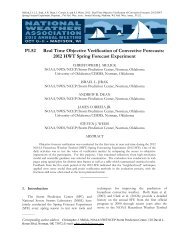
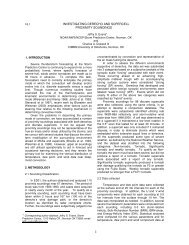
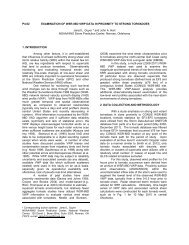
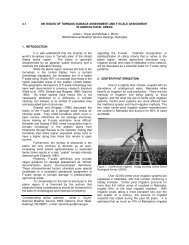
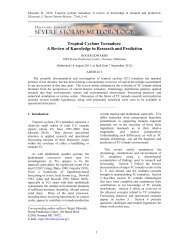

![NSWW_ROC_Overview.ppt [Read-Only] - Storm Prediction Center ...](https://img.yumpu.com/26478320/1/190x146/nsww-roc-overviewppt-read-only-storm-prediction-center-.jpg?quality=85)
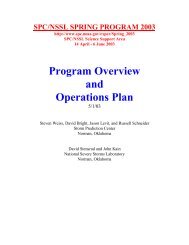
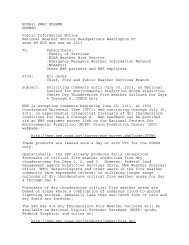
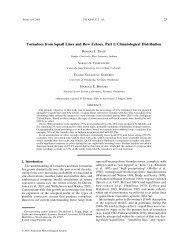

![NEW_PRODUCTS_imy.ppt [Read-Only] - Storm Prediction Center ...](https://img.yumpu.com/26478296/1/190x146/new-products-imyppt-read-only-storm-prediction-center-.jpg?quality=85)
